A New Perspective of the Spring Predictability Barrier Based on the Zonal Sea Level Pressure Gradient
Abstract
:1. Introduction
2. Datasets and Methods
2.1. Datasets
2.2. Methods
3. The Seasonal and Decadal Perspectives of SPB According to the Variability of Zonal SLP Gradient Over Equatorial Pacific
3.1. A New SPB Index
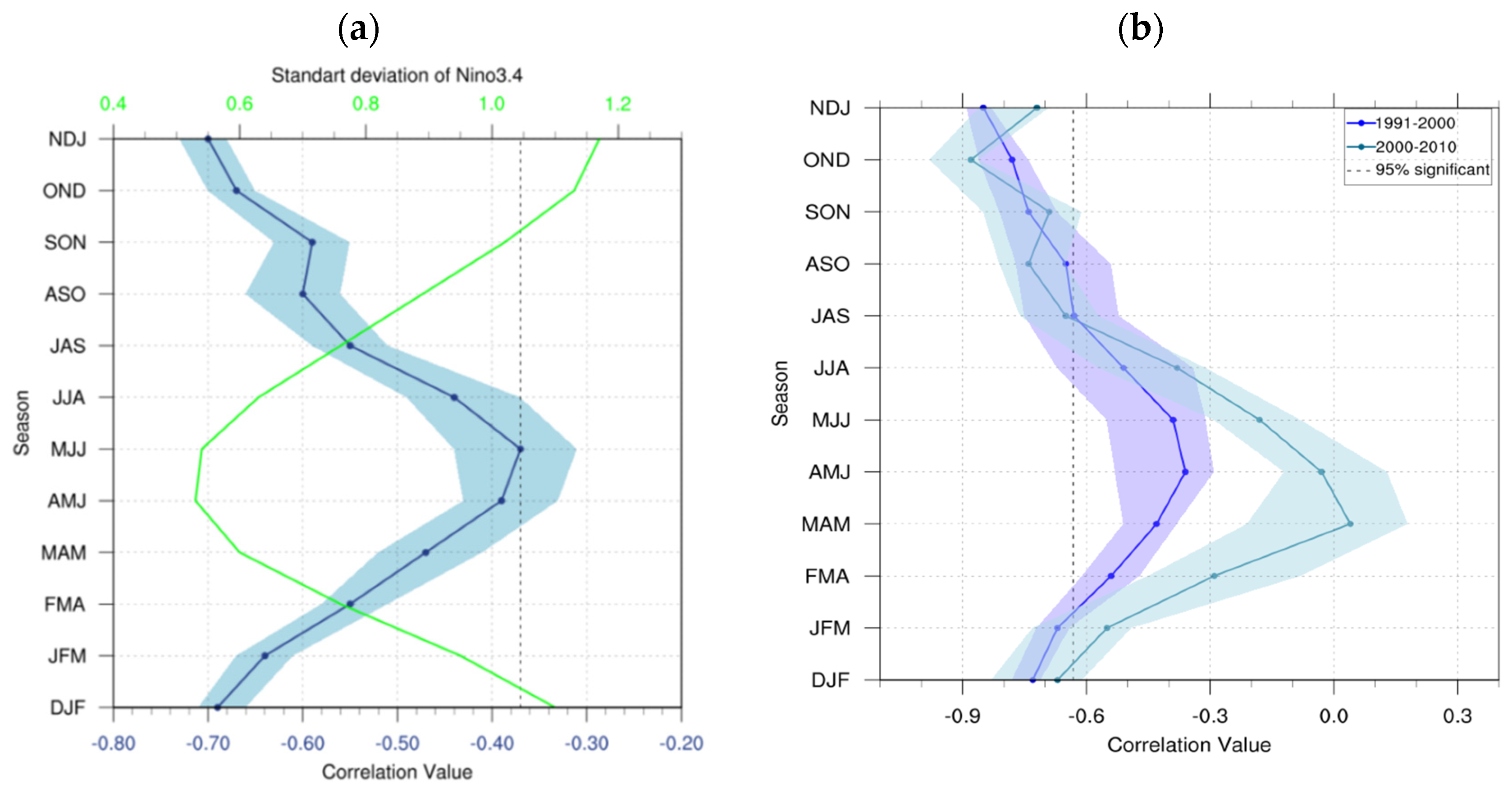
3.2. Decadal Variation of SPBS and Its Physical Reasons
4. Decadal Variation of SPBS in IRI/CPC Multi-Model Prediction System
5. Conclusions and Discussion
Author Contributions
Funding
Institutional Review Board Statement
Informed Consent Statement
Data Availability Statement
Acknowledgments
Conflicts of Interest
References
- Zebiak, S.E.; Cane, M.A. A model El Niño-Southern Oscillation. Mon. Wea. Rev. 1987, 115, 2262–2278. [Google Scholar] [CrossRef]
- Latif, M.; Anderson, D.; Barnett, T.; Cane, M.; Kleeman, R.; Leetmaa, A.; O’Brien, J.; Rosati, A.; Schneider, E. A review of the predictability and prediction of ENSO. J. Geophys. Res. 1998, 103, 14375–14393. [Google Scholar] [CrossRef]
- Chen, D.; Cane, M.; Kaplan, A.; Zebiak, S.E.; Huang, D.J. Predictability of El Niño over the past 148 years. Nature 2004, 428, 733–736. [Google Scholar] [CrossRef]
- Zheng, F.; Zhu, J.; Zhang, R.H.; Zhou, G. Improved ENSO forecasts byassimilating sea surface temperature observations into an intermediate coupled model. Adv. Atmos. Sci. 2006, 23, 615–624. [Google Scholar] [CrossRef]
- Jin, E.K.; Kinter, J.L.; Wang, B.; Park, C.-K.; Kang, I.-S.; Kirtman, B.P.; Kug, J.-S.; Kumar, A.; Luo, J.-J.; Schemm, J.; et al. Current status of ENSO prediction skill in coupled ocean–atmosphere models. Clim. Dyn. 2008, 31, 647–664. [Google Scholar] [CrossRef]
- Tippett, M.K.; Barnston, A.G. Skill of Multimodel ENSO Probability Forecasts. Mon. Wea. Rev. 2008, 136, 3933–3946. [Google Scholar] [CrossRef]
- Luo, J.; Masson, S.; Behera, S.; Shingu, S.; Yamagata, T. Seasonal Climate Predictability in a Coupled OAGCM Using a Different Approach for Ensemble Forecasts. J. Clim. 2005, 18, 4474–4497. [Google Scholar] [CrossRef]
- Barnston, A.G.; Tippett, M.K.; L’Heureux, M.L.; Li, S.; DeWitt, D.G. Skill of Real-Time Seasonal ENSO Model Predictions during 2002–11: Is Our Capability Increasing? Bull. Amer. Meteor. Soc. 2012, 93, ES48–ES50. [Google Scholar] [CrossRef]
- Zheng, F.; Zhu, J. Improved ensemble-mean forecasting of ENSO events by a zero-mean stochastic error model of an intermediate coupled model. Clim. Dyn. 2016, 47, 3901–3915. [Google Scholar] [CrossRef]
- Webster, P.J.; Yang, S. Monsoon and Enso: Selectively Interactive Systems. Q. J. R. Meteorol. Soc. 1992, 118, 877–926. [Google Scholar] [CrossRef]
- Balmaseda, M.A.; Davey, M.K.; Anderson, D.L.T. Decadal and Seasonal Dependence of ENSO Prediction Skill. J. Clim. 1995, 8, 2705–2715. [Google Scholar] [CrossRef]
- Zheng, F.; Zhu, J. Spring predictability barrier of ENSO events from the perspective of an ensemble prediction system. Glob. Planet. Chang. 2010, 72, 108–117. [Google Scholar] [CrossRef]
- Duan, W.; Liu, X.; Zhu, K.; Mu, M. Exploring the initial errors that cause a significant “spring predictability barrier” for El Niño events. J. Geophys. Res. 2009, 114, C04022. [Google Scholar] [CrossRef]
- Kirtman, B.P. The COLA Anomaly Coupled Model: Ensemble ENSO Prediction. Mon. Wea. Rev. 2003, 131, 2324–2341. [Google Scholar] [CrossRef]
- Duan, W.; Hu, J. The initial errors that induce a significant “spring predictability barrier” for El Niño events and their implications for target observation: Results from an earth system model. Clim. Dyn. 2015, 46, 3599–3615. [Google Scholar] [CrossRef]
- Duan, W.; Wei, C. The ‘spring predictability barrier’ for ENSO predictions and its possible mechanism: Results from a fully coupled model. Int. J. Climatol. 2012, 33, 1280–1292. [Google Scholar] [CrossRef]
- Ren, H.-L.; Jin, F.-F.; Tian, B.; Scaife, A.A. Distinct persistence barriers in two types of ENSO. Geophys. Res. Lett. 2016, 43, 10973–10979. [Google Scholar] [CrossRef]
- Jin, Y.; Liu, Z. A Theory of the Spring Persistence Barrier on ENSO. Part I: The Role of ENSO Period. J. Clim. 2021, 34, 2145–2155. [Google Scholar] [CrossRef]
- Jin, Y.; Liu, Z.; Duan, W. The Different Relationships between the ENSO Spring Persistence Barrier and Predictability Barrier. J. Clim. 2022, 35, 6207–6218. [Google Scholar] [CrossRef]
- McPhaden, M.J. Tropical Pacific Ocean heat content variations and ENSO persistence barriers. Geophys. Res. Lett. 2003, 30, 1480. [Google Scholar] [CrossRef]
- Yu, J.Y.; Kao, H.-Y. Decadal changes of ENSO persistence barrier in SST and ocean heat content indices: 1958–2001. J. Geophys. Res. 2007, 112, D13106. [Google Scholar] [CrossRef]
- Thompson, C.J.; Battisti, D.S. A Linear Stochastic Dynamical Model of ENSO. Part II: Analysis. J. Clim. 2001, 14, 445–466. [Google Scholar] [CrossRef]
- Torrence, C.; Webster, P.J. The annual cycle of persistence in the El Niño/Southern Oscillation. Q. J. R. Meteorol. Soc. 1998, 124, 1985–2004. [Google Scholar] [CrossRef]
- Hu, Z.; Kumar, A.; Ren, H.; Wang, H.; L’Heureux, M.; Jin, F. Weakened Interannual Variability in the Tropical Pacific Ocean since 2000. J. Clim. 2013, 26, 2601–2613. [Google Scholar] [CrossRef]
- Kumar, A.; Hu, Z.Z. Interannual and interdecadal variability of ocean temperature along the equatorial Pacific in conjunction with ENSO. Clim. Dyn. 2014, 42, 1243–1258. [Google Scholar] [CrossRef]
- Neske, S.; McGregor, S. Understanding the warm water volume precursor of ENSO events and its interdecadal variation. Geophys. Res. Lett. 2018, 45, 1577–1585. [Google Scholar] [CrossRef]
- Hu, Z.; Kumar, A.; Huang, B.; Zhu, J.; L’Heureux, M.; McPhaden, M.J.; Yu, J. The Interdecadal Shift of ENSO Properties in 1999/2000: A Review. J. Clim. 2020, 33, 4441–4462. [Google Scholar] [CrossRef]
- McPhaden, M.J.; Lee, T.; McClurg, D. El Niño and its relationship to changing background conditions in the tropical Pacific Ocean. Geophys. Res. Lett. 2011, 38, L15709. [Google Scholar] [CrossRef]
- Kosaka, Y.; Xie, S.P. Recent global-warming hiatus tied to equatorial Pacific surface cooling. Nature 2013, 501, 403–407. [Google Scholar] [CrossRef]
- Xiang, B.; Wang, B.; Li, T. A new paradigm for the predominance of standing Central Pacific Warming after the late 1990s. Clim. Dyn. 2013, 41, 327–340. [Google Scholar] [CrossRef]
- Zhu, J.; Kumar, A.; Huang, B. The relationship between thermocline depth and SST anomalies in the eastern equatorial Pacific: Seasonality and decadal variations. Geophys. Res. Lett. 2015, 42, 4507–4515. [Google Scholar] [CrossRef]
- Fang, X.H.; Mu, M. Both air-sea components are crucial for El Niño forecast from boreal spring. Sci. Rep. 2018, 8, 10501. [Google Scholar] [CrossRef]
- Lübbecke, J.F.; McPhaden, M.J. Assessing the Twenty-First-Century Shift in ENSO Variability in Terms of the Bjerknes Stability Index. J. Clim. 2014, 27, 2577–2587. [Google Scholar] [CrossRef]
- Fang, X.H.; Zheng, F.; Liu, Z.Y.; Zhu, J. Decadal modulation of ENSO spring persistence barrier by thermal damping processes in the observation. Geophys. Res. Lett. 2019, 46, 6892–6899. [Google Scholar] [CrossRef]
- Liu, Z.; Jin, Y.; Rong, X. A theory for the seasonal predictability barrier: Threshold, timing, and intensity. J. Clim. 2019, 32, 423–443. [Google Scholar] [CrossRef]
- Rayner, N.A.; Parker, D.E.; Horton, E.B.; Folland, C.K.; Alexander, L.V.; Rowell, D.P.; Kent, E.C.; Kaplan, A. Global analyses of sea surface temperature, sea ice, and night marine air temperature since the late nineteenth century. J. Geophys. Res. 2003, 108, 4407. [Google Scholar] [CrossRef]
- Kalnay, E. Coauthors. The NCEP/NCAR 40-Year Reanalysis Project. Bull. Am. Meteor. Soc. 1996, 77, 437–472. [Google Scholar] [CrossRef]
- Henley, B.J.; Gergis, J.; Karoly, D.J.; Power, S.; Kennedy, J.; Folland, C.K. A Tripole Index for the Interdecadal Pacific Oscillation. Clim. Dyn. 2015, 45, 3077–3090. [Google Scholar] [CrossRef]
- Gelfand, A.E.; Dey, D.K. Bayesian Model Choice: Asymptotics and Exact Calculations. J. R. Stat. Soc. Ser. B 1994, 56, 501–514. [Google Scholar] [CrossRef]
- Wang, B. The Vertical Structure and Development of the ENSO Anomaly Mode during 1979–1989. J. Atmos. Sci. 1992, 49, 698–712. [Google Scholar] [CrossRef]
- An, S.; Wang, B. Mechanisms of Locking of the El Niño and La Niña Mature Phases to Boreal Winter. J. Clim. 2001, 14, 2164–2176. [Google Scholar] [CrossRef]
- Yan, B.L. On the mechanism of the locking of the El Niño event onset phase to boreal spring. Adv. Atmos. Sci. 2005, 22, 741–750. [Google Scholar] [CrossRef]
- Tian, B.; Ren, H.-L.; Jin, F.-F.; Stuecker, M.F. Diagnosing the representation and causes of the ENSO persistence barrier in CMIP5 simulations. Clim. Dyn. 2019, 53, 2147–2160. [Google Scholar] [CrossRef]
- Clarke, A.J.; Gorder, S.V. The Connection between the Boreal Spring Southern Oscillation Persistence Barrier and Biennial Variability. J. Clim. 1999, 12, 610–620. [Google Scholar] [CrossRef]
- Latif, M.; Barnett, T.P.; Cane, M.A.; Flügel, M.; Graham, N.E.; von Storch, H.; Xu, J.-S. A review of ENSO prediction studies. Clim. Dyn. 1994, 9, 167–179. [Google Scholar] [CrossRef]
- Mu, M.; Xu, H.; Duan, W. A kind of initial errors related to “spring predictability barrier” for El Niño events in Zebiak-Cane model. Geophys. Res. Lett. 2007, 34, L03709. [Google Scholar] [CrossRef]
- van Oldenborgh, G.J.; Balmaseda, M.A.; Ferranti, L.; Stockdale, T.N.; Anderson, D.L.T. Did the ECMWF Seasonal Forecast Model Outperform Statistical ENSO Forecast Models over the Last 15 Years? J. Clim. 2005, 18, 3240–3249. [Google Scholar] [CrossRef]
- Webster, P.J. The annual cycle and the predictability of the tropical coupled ocean-atmosphere system. Meteorl. Atmos. Phys. 1995, 56, 33–55. [Google Scholar] [CrossRef]
- Yu, J.-Y. Enhancement of ENSO’s persistence barrier by biennial variability in a coupled atmosphere-ocean general circulation model. Geophys. Res. Lett. 2005, 32, L13707. [Google Scholar] [CrossRef]
- Wang, B.; Fu, X.H. Processes determining the rapid reestablishment of the equatorial Pacific cold tongue/ITCZ complex. J. Clim. 2001, 14, 2250–2265. [Google Scholar] [CrossRef]
- Wang, B.; Wang, Y.Q. Dynamics of the itcz-equatorial cold tongue complex and causes of the latitudinal climate asymmetry. J. Clim. 1999, 12, 1830–1847. [Google Scholar] [CrossRef]
- Philander, S.G.H. El Niño Southern Oscillation phenomena. Nature 1983, 302, 295–301. [Google Scholar] [CrossRef]
- Battisti, D.S. Dynamics and thermodynamics of a warming event in a coupled tropical atmosphere–ocean model. J. Atmos. Sci. 1988, 45, 2889–2919. [Google Scholar] [CrossRef]
- Tziperman, E.; Zebiak, S.E.; Cane, M.A. Mechanisms of seasonal–ENSO interaction. J. Atmos. Sci. 1997, 54, 61–71. [Google Scholar] [CrossRef]
- Li, T. Phase transition of the El Niño–Southern Oscillation: A stationary SST mode. J. Atmos. Sci. 1997, 54, 2872–2887. [Google Scholar] [CrossRef]
- Bjerknes, J. Atmospheric Teleconnections from the Equatorial Pacific. Mon. Weather. Rev. 1969, 97, 163–172. [Google Scholar] [CrossRef]
- Okumura, Y.M.; Sun, T.; Wu, X. Asymmetric modulation of El Niño and La Niña and the linkage to tropical Pacific decadal variability. J. Clim. 2017, 30, 4705–4733. [Google Scholar] [CrossRef]
- Lin, R.; Zheng, F.; Dong, X. ENSO frequency asymmetry and the Pacific decadal oscillation in observations and 19 CMIP5 models. Adv. Atmos. Sci. 2018, 35, 495–506. [Google Scholar] [CrossRef]
- Jin, Y.; Lu, Z.; Liu, Z. Controls of spring persistence barrier strength in different ENSO regimes and implications for 21st century changes. Geophys. Res. Lett. 2020, 47, e2020GL088010. [Google Scholar] [CrossRef]
- Jean-Louis, P. The Anticipation of the ENSO: What Resonantly Forced Baroclinic Waves Can Teach Us (Part II). J. Mar. Sci. Eng. 2018, 6, 63. [Google Scholar] [CrossRef]
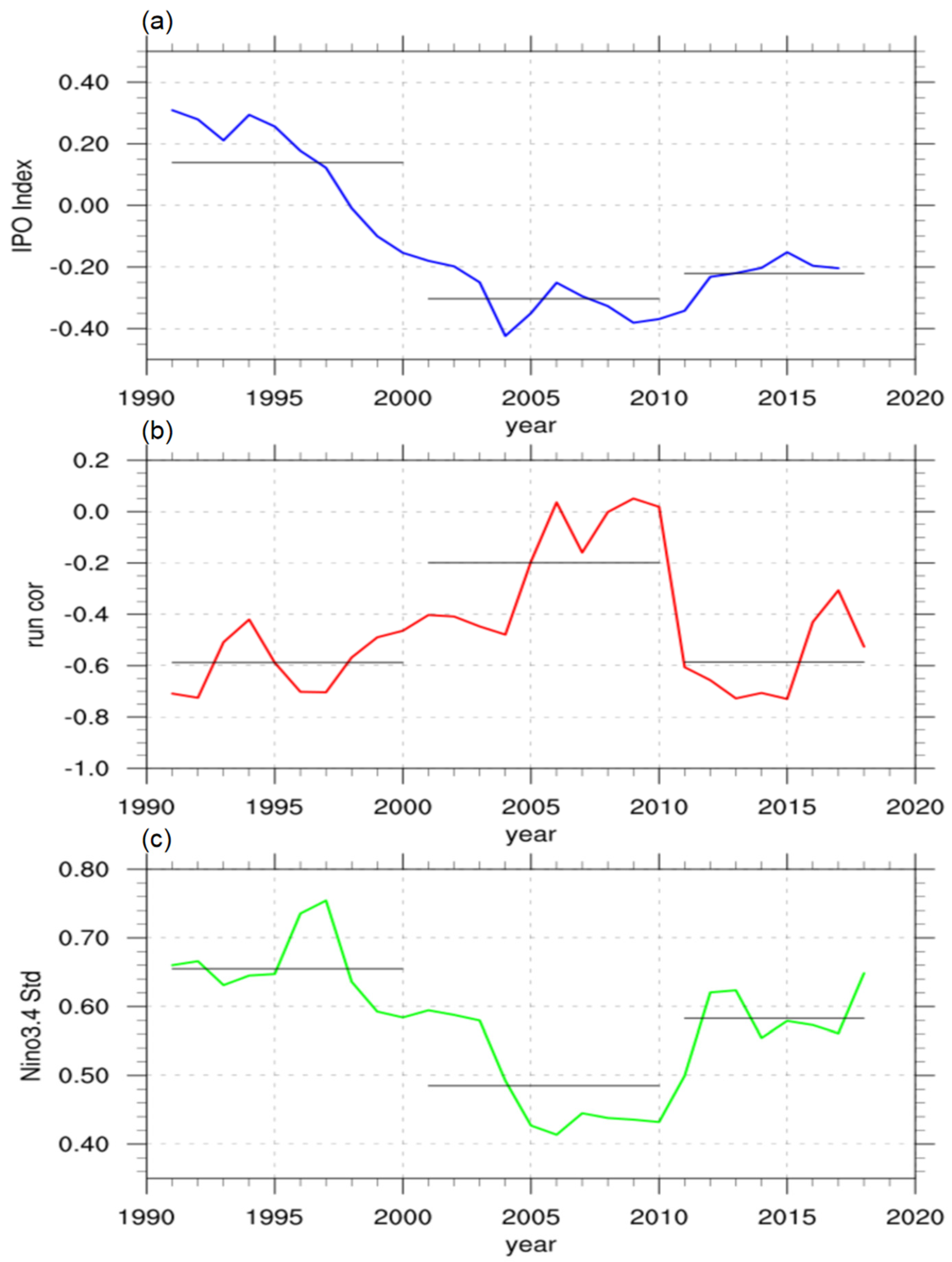
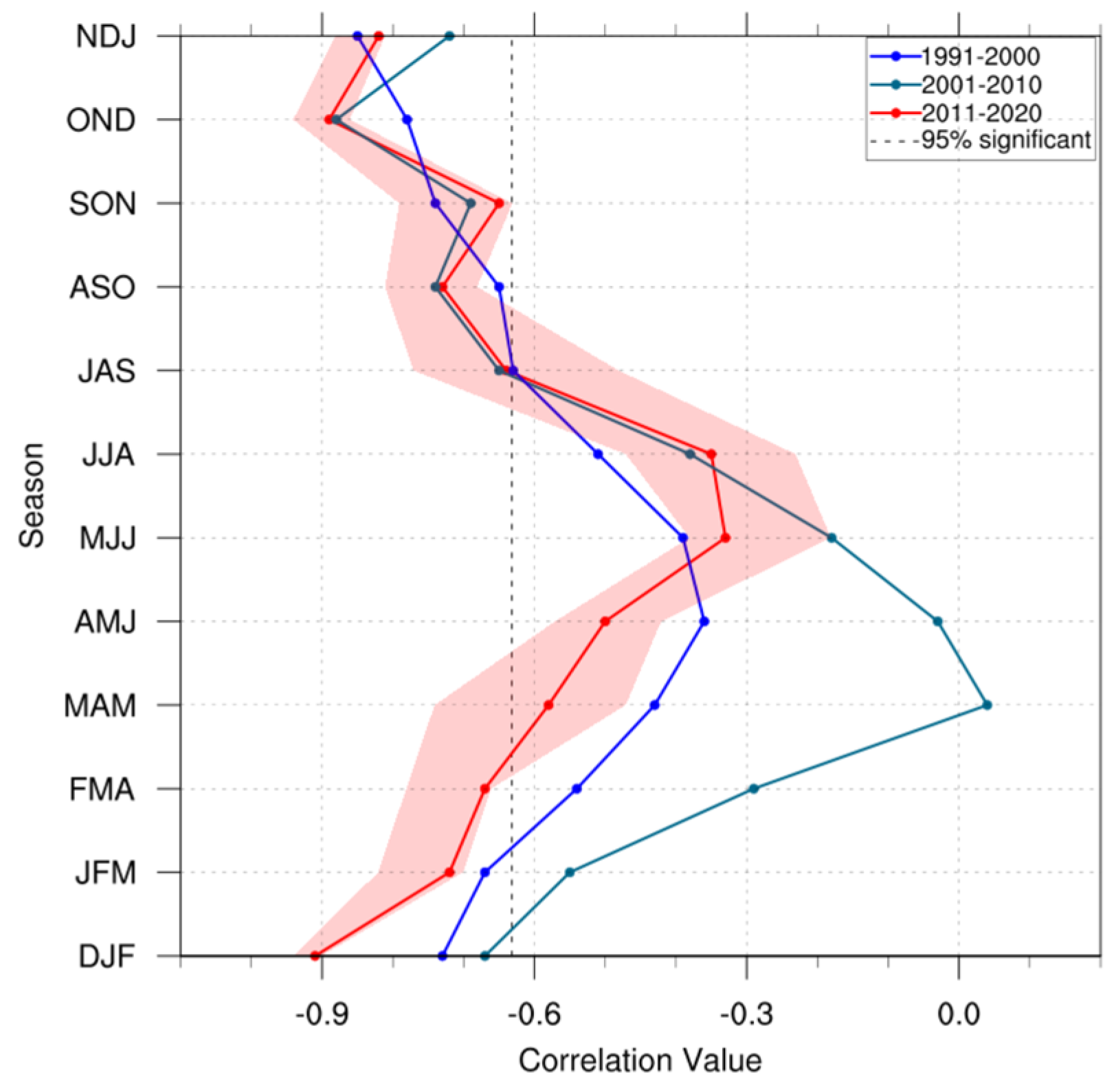

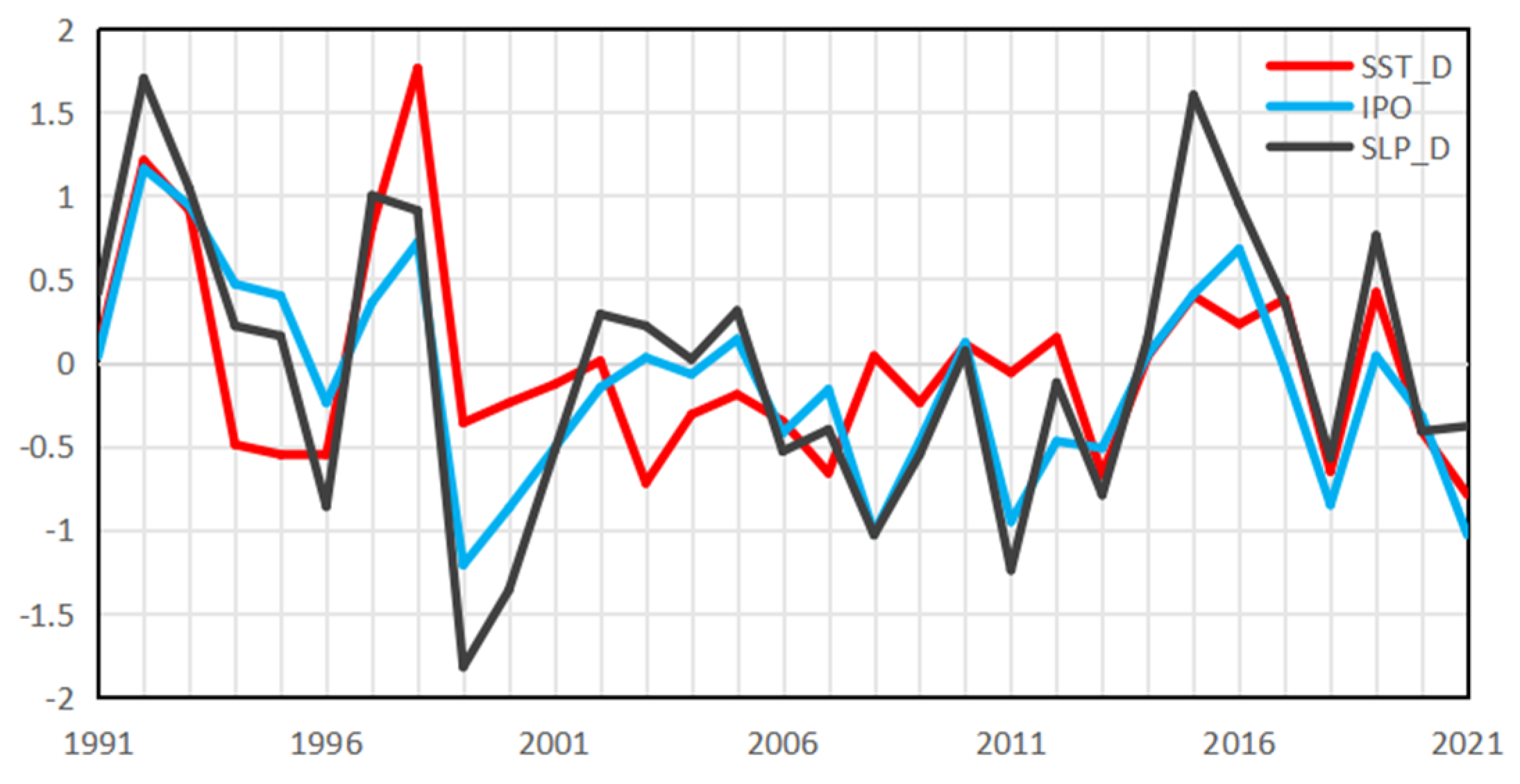
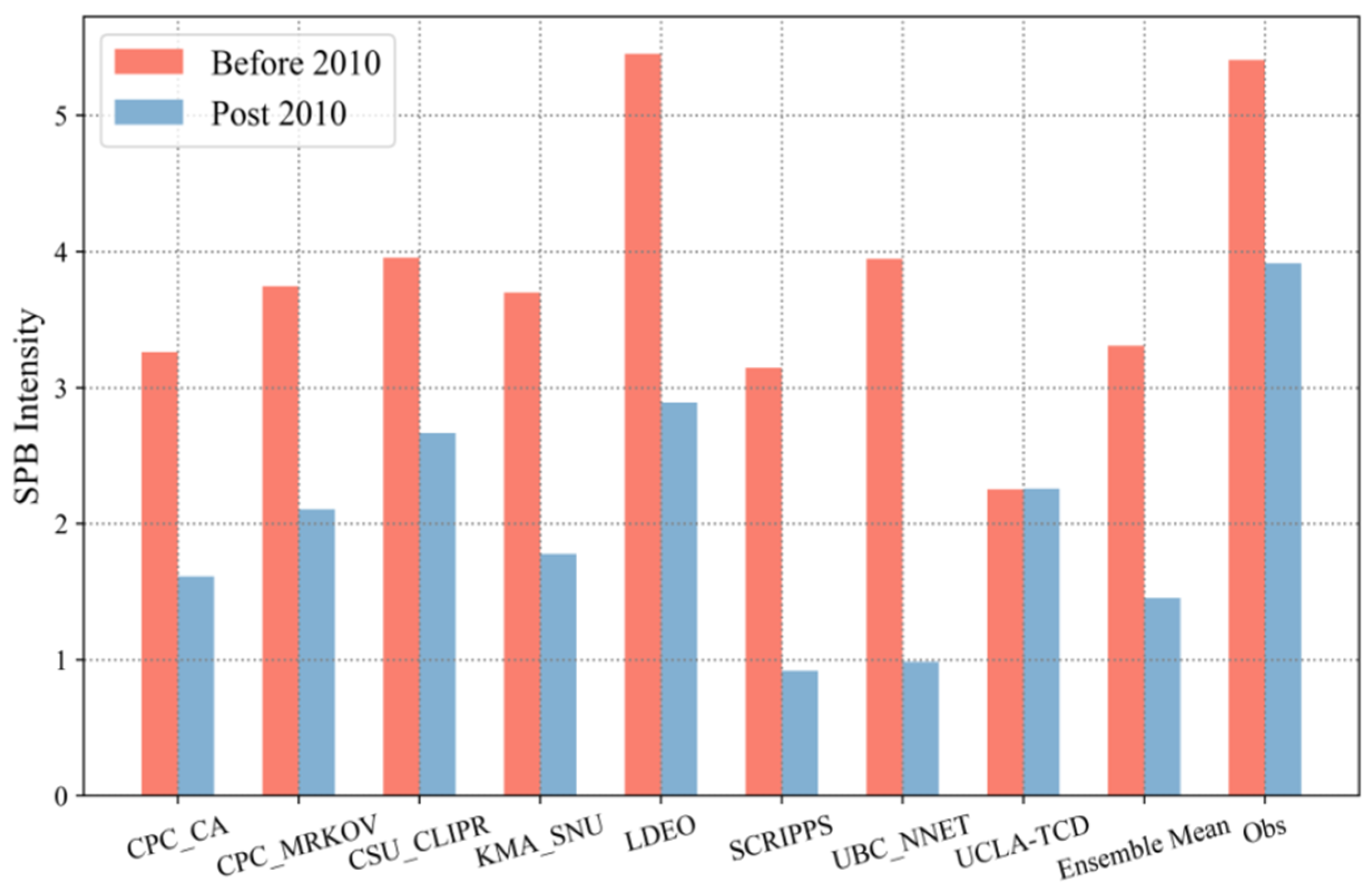
Disclaimer/Publisher’s Note: The statements, opinions and data contained in all publications are solely those of the individual author(s) and contributor(s) and not of MDPI and/or the editor(s). MDPI and/or the editor(s) disclaim responsibility for any injury to people or property resulting from any ideas, methods, instructions or products referred to in the content. |
© 2024 by the authors. Licensee MDPI, Basel, Switzerland. This article is an open access article distributed under the terms and conditions of the Creative Commons Attribution (CC BY) license (https://creativecommons.org/licenses/by/4.0/).
Share and Cite
Tan, J.; Zheng, F.; Cao, T.; Huang, Y.; Wang, H. A New Perspective of the Spring Predictability Barrier Based on the Zonal Sea Level Pressure Gradient. J. Mar. Sci. Eng. 2024, 12, 1463. https://doi.org/10.3390/jmse12091463
Tan J, Zheng F, Cao T, Huang Y, Wang H. A New Perspective of the Spring Predictability Barrier Based on the Zonal Sea Level Pressure Gradient. Journal of Marine Science and Engineering. 2024; 12(9):1463. https://doi.org/10.3390/jmse12091463
Chicago/Turabian StyleTan, Jing, Fei Zheng, Tingwei Cao, Yongyong Huang, and Haiyan Wang. 2024. "A New Perspective of the Spring Predictability Barrier Based on the Zonal Sea Level Pressure Gradient" Journal of Marine Science and Engineering 12, no. 9: 1463. https://doi.org/10.3390/jmse12091463




